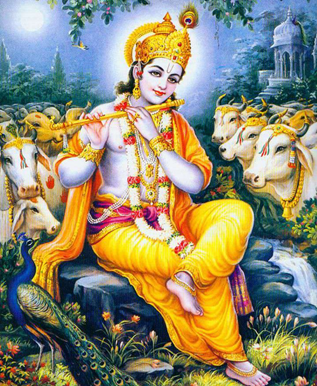
Lord Krishna is one of the most popular Gods in Hinduism. Krishna is considered the supreme deity, worshipped across many traditions of Hinduism in a variety of different perspectives. Krishna is recognized as the eighth incarnation (avatar) of Lord Vishnu, and one and the same as Lord Vishnu, one of the trimurti and as the supreme god in his own right. Krishna is the principal protagonist with Arjuna in the Bhagavad Gita also known as the Song of God, which depicts the conversation between the Royal Prince Arjuna and Krishna during the great battle of Kureksetra 5000 years ago where Arjuna discovers that Krishna is God and then comprehends his nature and will for him and for mankind. In present age Krishna is one of the most widely revered and most popular of all Indian divinities.
Each incarnation of Lord Vishnu on the Earth is with a purpose and to accomplish some definite tasks. Lord Krishna came to the Earth to kill king Kansa and to relieve the people of Braj from his torture and tyranny. Later Krishna participated in the events of the Mahabharata and Lord Krishna’s participation had profound effect on the Mahabharata war and its consequences.
The tradition of Krishna appears to be an amalgamation of several independent deities of ancient India, the earliest to be attested being Vāsudeva. Vāsudeva was a hero-god of the tribe of the Vrishnis, belonging to the Vrishni heroes, whose worship is attested from the 5th-6th century BCE in the writings of Pāṇini, and from the 2nd century BCE in epigraphy with the Heliodorus pillar. At one point in time, it is thought that the tribe of the Vrishnis fused with the tribe of the Yadavas, whose own hero-god was named Krishna. Vāsudeva and Krishna fused to become a single deity, which appears in the Mahabharata, and they start to be identified with Vishnu in the Mahabharata and the Bhagavad Gita. Around the 4th century CE, another tradition, the cult of Gopala-Krishna, the protector of cattle, was also absorbed into the Krishna tradition.
The name Krishna originates from the Sanskrit word Kṛṣṇa, which is primarily an adjective meaning “black”, “dark” or “dark blue”. The waning moon is called Krishna Paksha in the Vedic tradition, relating to the adjective meaning “darkening”.
As a name of Vishnu, Krishna is listed as the 57th name in the Vishnu Sahasranamam. Krishna is also known by various other names, epithets and titles, which reflect his many associations and attributes. Among the most common names are Mohan “enchanter”, Govinda, “Finder of the cows” or Gopala, “Protector of the cows”, which refer to Krishna’s childhood in Braj (in present day Uttar Pradesh). Some of the distinct names may be regionally important; for instance, Jagannatha, a popular incarnation of Puri, Odisha in eastern India.
The Chandogya Upanishad, estimated to have been composed sometime between the 8th and 6th centuries BCE, has been another source of speculation regarding Krishna in ancient India. Krishnaya Devakiputraya as a student of the sage Ghor' of the Angirasa family. Ghora is identified with Neminatha, the twenty-second tirthankara in Jainism, by some scholars. This phrase, which means "To Krishna the son of Devaki", has been mentioned by scholars such as Max Müller as a potential source of fables and Vedic lore about Krishna in the Mahabharata and other ancient literature – only potential because this verse could have been interpolated into the text, or the Krishna Devakiputra, could be different from the deity Krishna.
Lord Krishna was the eighth son born to the princess Devaki and her husband Vasudeva in Mathura city. However Krishna raised by his foster parents Yashoda and Nanda in Gokul a small village in Mathura district.
Krishna had eight princely wives, also known as Ashtabharya: Rukmini, Satyabhama, Jambavati, Nagnajiti, Kalindi, Mitravinda, Bhadra, Lakshmana) and the other 16,100 or 16,000 (number varies in scriptures), who were rescued from Narakasura. They had been forcibly kept in his palace and after Krishna had killed Narakasura, he rescued these women and freed them. Krishna married them all to save them from destruction and infamity. He gave them shelter in his new palace and a respectful place in society. The chief amongst them is Rohini.
The Bhagavata Purana, Vishnu Purana, Harivamsa list the children of Krishna from the Ashtabharya with some variation; while Rohini’s sons are interpreted to represent the unnumbered children of his junior wives. Most well-known among his sons are Pradyumna, the eldest son of Krishna (and Rukmini) and Samba, the son of Jambavati, whose actions led to the destruction of Krishna’s clan.
Krishna is easily recognized by his representations. Though his skin color may be depicted as black or dark in some representations, particularly in murtis, in other images such as modern pictorial representations, Krishna is usually shown with a blue skin. He is often shown wearing a silk dhoti and a peacock feather crown. Common depictions show him as a little boy or as a young man in a characteristically relaxed pose, playing the flute. In this form, he usually stands with one leg bent in front of the other with a flute raised to his lips, in the Tribhanga posture, accompanied by cows, emphasizing his position as the divine herdsman, Govinda, or with the gopis (milkmaids) i.e. Gopikrishna, stealing butter from neighbouring houses i.e. Navneet Chora or Gokulakrishna, defeating the vicious serpent i.e. Kaliya Damana Krishna, lifting the hill i.e. Giridhara Krishna, so on and so forth from his childhood / youth events.

5

27Nov2022

Add

3

1

1

4



